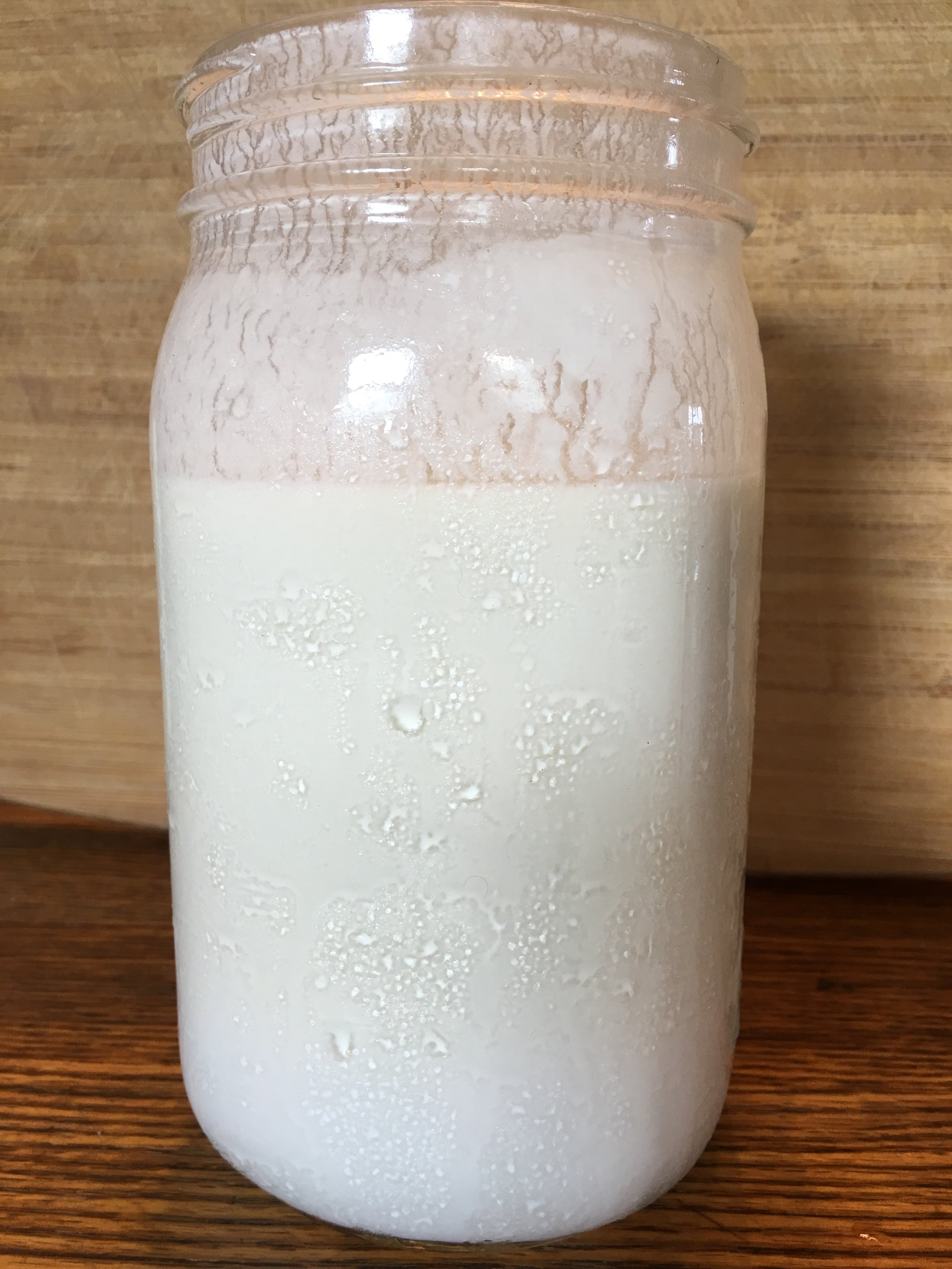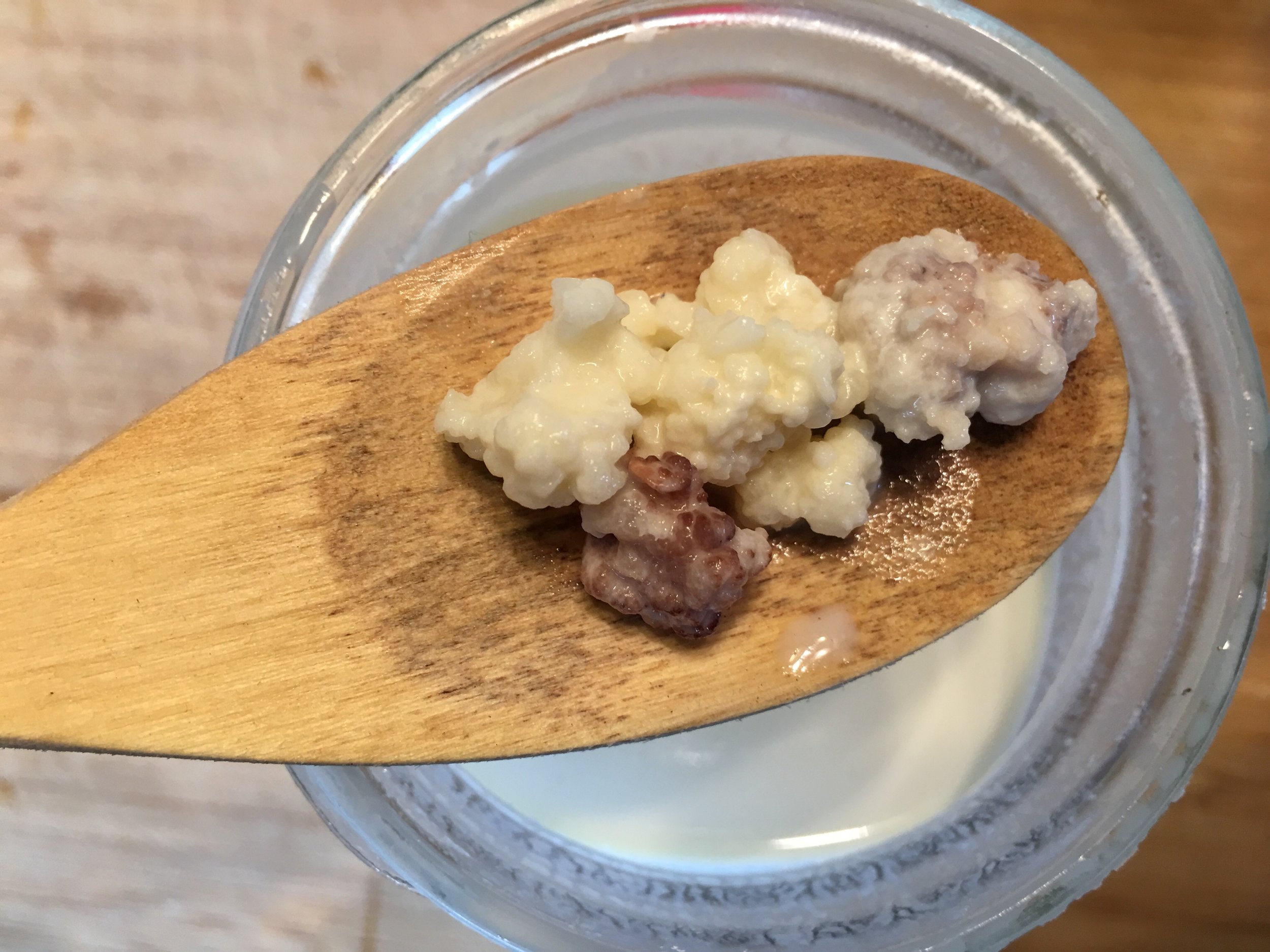What the heck is Kefir and how can it help your gut issues?
I learned of Kefir several years ago.
And just learned a couple years ago that I was pronouncing it wrong… the whole time.
I say kee-fur, you say ke-feer (rhymes with deer…). The latter is correct.
Besides learning about ALL the benefits of Kefir, I also learned how hard it is to change the way you say a word after saying it wrong for two years!
But no matter how you say it, it’s SOOOO SUPER GOOD FOR YOU!
Not yelling, just want you to know how great it really is.
Kefir is considered one of the, if not THEE, most powerful probiotics out there. It’s been around for centuries.
It seems the origin is a little sketchy and no one really knows how it came about.
I’m talkin’ actual kefir grains (as you’ll see pictured below).
Not powdered kefir or the kefir milk in the store. That’s just loaded down with sugar and other stuff. Plus it doesn’t have the LONG list of good-for-you bacteria and yeast.
I hope being nerdy isn’t going to be too boring..
Kefir grains are like a SCOBY for milk. Ever heard of Kombucha? That’s for another blog LOL! But Kombucha is made with a SCOBY, which stands for Symbiotic Culture of Bacteria and Yeast.
Unlike yogurt, which cooks the milk first, Kefir, you get to keep all the “good stuff” in the raw milk, plus add, like, a bazillion more. No joke!
I don’t know what half of these words are, but google can help you with that if you’re curious.
Lactobacilli
Lb. brevis
Lb. cellobiosus
Lb. acidophilus
Lb. casei ssp. alactosus
Lb. casei ssp. rhamnosus
Lb casei
Lb. helveticus ssp. lactis
Lb. delbrueckii ssp. lactis
Lb. delbrueckii ssp. bulgaricus
Lb. Lb. lactis
Lb. fructivorans
Lb. hilgardii
Lb. kefir
Lb. kefiranofaciens
Lb kefergranum sp. No
Lb. parakefir sp. Nov.
Streptococci. Lactococci
Lc. Lactis ssp. lactis
Lc. Lactis var. diacety lactis
S. salivarius ssp. thermophilus
S. lactis
Enterococcus durans
Leuconostoc cremoris
L. mesenteroides
Yeasts
Kluyveromyces lactis
Kluyveromyces marxianus var. marxianus
K. bulgaricus
K. fragilis/marxianus
Candida kefir
C. pseudopropicalis
Saccharomyces ssp. Torulopsis holmii
Acetobacter
Acetobacters aceti
A. rasens
Did you count that?? I think I got like 32.. ;)
Please do not get in touch with my high school English teacher to see if I spelled those right. Definitely can’t use spell check.
You can see why all those would help heal your leaky gut, ulcerative colitis, chron’s disease, IBS… But you may wonder how it can help with skin issues or health.
Your skin is the largest organ of your body, and it directly relates to your gut health. Some people even experience a super energized feeling after drinking kefir.
“Buh-b-b-b-BUT” you say. “How does it taste??!!”
Kefir milk can be thicker than milk (but doesn’t have to be), has a little zingy effervescence to it, and tastes like a mixture of yogurt & sour cream. To me anyway.
It took us a while to be able to drink straight Kefir milk.
Start out adding it to your smoothie. That’s the only way our kids would drink it. Then every day, just try to take a couple sips straight.
You’ll get used to it and find it’s actually GOOD. You can always add a little raw honey if you need a little sweetness.
Kefir grains look like little pieces of cauliflower but are soft and squishy.
They have to have milk to live. They are a living thing and they grow. You can actually ferment other things with Kefir grains.
Drop them in a jar of cream that you’ve skimmed off the top of your raw milk. That will make cultured cream, sour cream, cultured butter, etc. then you’ll have REAL butter milk after churning butter.
The grains can also ferment store bought milk (results are not as great as raw milk) or even coconut milk, they just grow slower.
You can even make “soda” by putting them in 100% juice. BUT, they must go back into milk soon or they will die.
Some of mine are pink & purple from fermenting strawberry and grape juice. That also makes them easier to see in your milk :)
A few things to remember about Kefir grains:
They are alive, kind of like a new pet, but much easier.
They can ferment nut “milks” (which is actually juice, not milk, don’t get me started;), but the grains won’t grow and will eventually disappear if kept in nut juice for long periods of time.
Grains always need milk to stay alive and growing.
Silicone is no bueno for Kefir grains. Use a mesh strainer, stainless steal is OK too. Wooden or plastic spoons to stir or scoop out grains are best.
There are also water Kefir grains, I don’t know much about them. Apparently you ferment water???
Here’s the low-down on how to make your own kefir:
1 tsp to 1 TBSP of kefir grains (I only need a 1/4-1/2 inch grain to ferment a half gallon of milk)
1 qt to a half gallon of raw milk (cow or goat)
drop grain(s) in milk and ferment at room temp (ideal 70-75*) for 24 hours.
After 24 hours, either pour your Kefir milk through a strainer, or fish out the grains with a spoon or fork.
Put the grains in a jar of fresh milk. If they’re colored like mine, and you only use 1 grain, just scoop it off the top with a fork & plop into fresh milk.
This has to be done every 24 hours.
If, in 24 hours, the taste or consistency of the milk has not changed, you either need less milk or more grains.
It’s trial and error at first until you get the hang of it.
Seems every season I have to adjust the ratio of milk/grains, because room temp. in our 100+-year-old farmhouse is different with each season.
In the summer, as the 24 hour mark gets closer, I check the Kefir milk by shaking the jar whenever I think about it. Still liquid, not thicker, still smells like milk, so I leave it longer…
Half hour later, BAM, solid clump… :( just adjust as needed for your house.
So, now you’re tired of making Kefir every day. It’s like having another kid. You want to take a break. That’s easier to do with Kefir than with another kid, so let’s stick to Kefir.
Put all your grains in a small jar, pint or quart, fill it with milk. Store in your refrigerator. Change the milk monthly.
If you forget about it, no worries! I forget all the time.
It has actually separated into who-knows-what in my fridge. The kind of stuff that my kids look at me in disgust as I raise the spoon to my tongue for a tiny little taste.
Well, it’s never made me sick and doesn’t even taste that bad. To me anyway.
Just strain the grains out and add them to fresh milk, they’re very resilient.
After the grains have a mini vay-cay, they will take a few rounds of fermenting milk to get back into their groove. SLACKERS..
Need some kefir grains? Text me 309-530-4381 before you stop by and I’ll get them out in the store for you with an instruction sheet.
Happy Kee-fur, I mean, Ke-feer making!

Kefir Basics
Ingredients
- 1 tsp kefir grains
- 2 cups (pint) Hoffman's Little Acres Raw Milk
Instructions
- Drop grain(s) in milk and ferment at room temp (ideal 70-75*) for 24 hours.
- After 24 hours, either pour your Kefir milk through a strainer or fish out the grains with a spoon or fork.
- You may drink that milk, it may have thickened or may still be like milk, but it's ok to drink.
- Put the grains in a jar of fresh milk.
- Adjust more or less milk depending on the first batch.
- Add more milk if your kefir turned solid. Less milk if there was no change in taste.
- Let it sit on the counter for 24 hours
- Repeat steps 2-3 above.
- Place your kefir grain in another jar with a quart to a half gallon of milk.
- Let sit on the counter for 24 hours (it may take longer in the winter and shorter in the summer, so adjust the amount of milk or grains in the milk)
- You will have to taste the kefir to make adjustments.
- This has to be done every 24 hours.
- Remove the grains and store this drinkable kefir in the refrigerator
- Repeat every time you want to make more kefir
Notes
*If, in 24 hours, the taste or consistency of the milk has not changed, you either need less milk or more grains.
*It’s trial and error at first until you get the hang of it.*
Storing kefir grains:
- Store grains in a small jar with milk in the fridge. They WILL NOT DIE. Don't throw away your kefir grains
- Change the "storage" milk monthly.
Things that will kill kefir grains?
- Don't Heat your kefir or the grains
- Don't use Silicon spatulas


